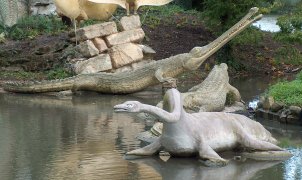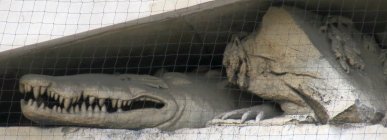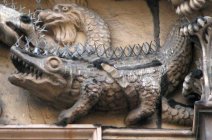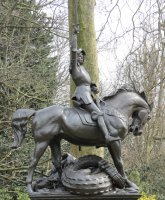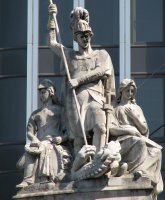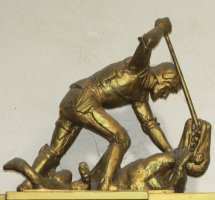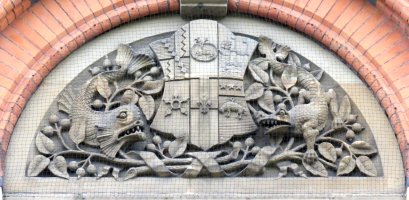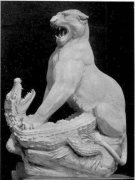Crocodile sculpture
Historic crocodile sculpture in England seems to be really quite unusual; here are a few examples.
Victorian and other historic crocodile sculpture is really rather rare in England in my experience. I realised this when seeing the statue of Osiris by Sebastian Gahagan at the Museum of London, who carries a small crocodile, and realised how infrequent it is to encounter a carved crocodile. Sitting down and thinking about it, so very few examples came to my mind, I thought it was vital to put them on record here.
Crystal Palace crocodile sculpture - Teleosaurus.
The best known pair of crocodiles, or rather the less familiar members of a well-known group of London sculpture, is within the assemblage of dinosaurs at Crystal Palace. The view here shows a gharial-like teleosaurus, from the Jurassic; his mate is shown crawling away, behind the long-necked plesiosaurus. Crocodiles are a bit like silverfish - having evolved to perfection a very long time ago - maybe 200 million years or so - they have essentially stayed the same ever since rather than felt any impulse to further evolve, and the teleosaurus sculptures, with its their long snout and distinctive enlarged nostrils at the end, were closely modelled on the gharial. Waterhouse Hawkins was the sculptor.
Another ancient type of crocodile is this one, wedged in the corner of a pediment and emerging from behind some lump - the set back position meant the sculptor could show the sharp teeth in fair confidence that they would not decay away. Victorian again.
Liverpool's crocodile.
Rather older, we have this charming, lively little beast, as part of the decoration of the Old Town Hall in Dale Street, Liverpool. While we mostly see the scaled flank and legs, the tail is twisted upward, and we can also see the characteristic parallel rows of spikes on the top of the tail, which are also found on the back of the beast. There is definitely a sculptural appeal to this sort of armour, and a few of the very numerous St George and the Dragon sculptural groups use a crocodilian style dragon with these spiky scales. The one which immediately leaps to mind is Adrian Jones's Cavalry monument in Hyde Park, shown below left in a view to emphasise that scaly back and tail (you will need to click to enlarge the picture to see properly). Also shown are two other examples - a large stone one with even more spiky scales on the neck of the dragon, centre, and to the right, a small St George group where the hapless animal is without visible scales, but in the process of being speared between its very crocodilian jaws.
St George and the 'crocodilian dragon' sculpture.
Purely decorative crocodile sculpture is represented in the two pictures below. To the left, an ancient Turkish crocodile in high relief, this being on the side of the Turkish gun displayed in Horseguards Parade, London. Rather a mournful grimace, and the beast raised up on its feet rather than resting on its stomach, so this crocodile is clearly in a hurry. There is another one on the other side of the gun. The second picture, below right, shows a lunette with a rock fish and a crocodile, both arboreal, which is not considered usual in either species, but with the crocodile having a leaf-like triple tail to emphasise the naturalness of it clambering up in the branches.
Decorative crocodile and fish.
Here is an Edwardian example, shown irritably snapping at a panther which is clawing at its neck: I fear that this rather small crocodile was destined never to grow to full size. The sculptor was the rather forgotten Charles Beacon, who exhibited some small number of animal sculptures, and settled in Bushey, so presumably associated with the Herkomer school and Lucy Kemp Welch.
Finally, to end, I wanted at least one standard, naturalistic crocodile, not doing anything odd but just reclining in crocodilian fashion with some nice African surroundings. I can only think of one - on the former Africa House in Kingsway, London, and so high up that most passers-by below likely hardly notice it is there.
